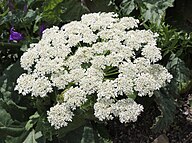
Persicaria perfoliata is a species of flowering plant in the buckwheat family. Common names include mile-a-minute, devil's tail, giant climbing tearthumb, and Asiatic tearthumb. It is a trailing herbaceous annual vine with barbed stems and triangular leaves. It is native to most of temperate and tropical eastern Asia, occurring from eastern Russia and Japan in the north, and the range extending to the Philippines and India in the south.

Heracleum is a genus of biennial and perennial herbs in the carrot family Apiaceae. They are found throughout the temperate northern hemisphere and in high mountains as far south as Ethiopia. Common names for the genus or its species include hogweed and cow parsnip.

Heracleum maximum, commonly known as cow parsnip, is the only member of the genus Heracleum native to North America. It is also known as American cow-parsnip, Satan celery, Indian celery, Indian rhubarb, poison turnip or pushki.

Heracleum mantegazzianum, commonly known as giant hogweed, is a monocarpic perennial herbaceous plant in the carrot family Apiaceae. H. mantegazzianum is also known as cartwheel-flower, giant cow parsley, giant cow parsnip, or hogsbane. In New Zealand, it is also sometimes called wild parsnip or wild rhubarb.

Prosopis juliflora is a shrub or small tree in the family Fabaceae, a kind of mesquite. It is native to Mexico, South America and the Caribbean. It has become established as an invasive weed in Africa, Asia, Australia and elsewhere. It is a contributing factor to continuing transmission of malaria, especially during dry periods when sugar sources from native plants are largely unavailable to mosquitoes.
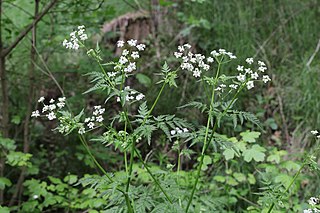
Anthriscus sylvestris, known as cow parsley, wild chervil, wild beaked parsley, Queen Anne's lace or keck, is a herbaceous biennial or short-lived perennial plant in the family Apiaceae (Umbelliferae), genus Anthriscus. It is also sometimes called mother-die, a name that is also applied to the common hawthorn. It is native to Europe, western Asia and northwestern Africa. It is related to other diverse members of Apiaceae, such as parsley, carrot, hemlock and hogweed. It is often confused with Daucus carota, another member of the Apiaceae also known as "Queen Anne's lace" or "wild carrot".
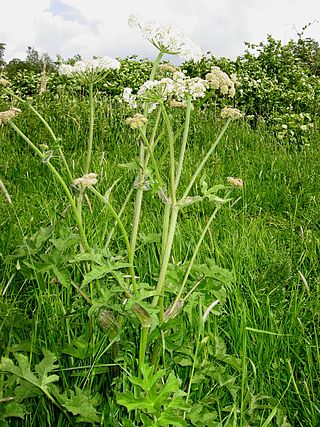
Heracleum sphondylium, commonly known as hogweed or common hogweed, is a herbaceous perennial plant in the carrot family Apiaceae, which includes fennel, cow parsley, ground elder and giant hogweed. It is native to most of Europe, western Asia and northern Africa, but is introduced in North America and elsewhere. Other common names include cow parsnip or eltrot. The flowers provide a great deal of nectar for pollinators.

Phytophotodermatitis, also known as berloque dermatitis, margarita photodermatitis, lime disease or lime phytodermatitis is a cutaneous phototoxic inflammatory reaction resulting from contact with a light-sensitizing botanical agent followed by exposure to ultraviolet A (UV-A) light. Symptoms include erythema, edema, blisters, and delayed hyperpigmentation. Heat and moisture tend to exacerbate the reaction.
Heracleum persicum, commonly known as Persian hogweed or by its native name Golpar is a species of hogweed, a perennial herbaceous plant in the carrot family Apiaceae. It grows wild in humid mountainous regions in Iran and some adjacent areas. Having been introduced in the 1830s, it has spread across Scandinavia. It is now very common in northern Norway, where one of its names is Tromsø palm. The plant has also been spotted in Sweden. In Finland, it has been declared an invasive species.

Lupinus nootkatensis, the Nootka lupine, is a perennial plant of the genus Lupinus in the legume family, Fabaceae. It is native to North America. The Nootka lupine grows up to 60 cm tall. Late in the 18th century it was first introduced to Europe.

Euleia heraclei, known as the celery fly or the hogweed picture-wing fly is a species of tephritid or fruit flies in the genus Euleia of the family Tephritidae.

Lagarosiphon major is a monocotic aquatic plant native to Southern Africa. Common names include African elodea, curly waterweed, oxygen weed and South African oxygen weed. It is used as freshwater aquarium plant.
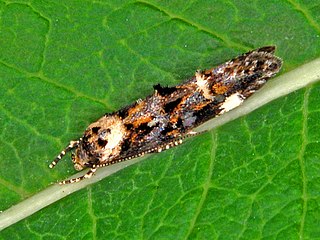
Mompha conturbatella, also known as the fireweed mompha moth, is a moth in the family Momphidae found in Asia, Europe and North America. It was first described by Jacob Hübner in 1819.
Hogweed is a common name for several unrelated plants.

Epermenia chaerophyllella, also known as the garden lance-wing, is a moth of the family Epermeniidae first described by Johann August Ephraim Goeze in 1783. It is found in all of Europe and Asia Minor.

Phaulernis dentella is a moth of the family Epermeniidae found in Asia and Europe. The moth was first described by Philipp Christoph Zeller in 1839.
Institute for Environmental Solutions (IES) is a non-profit research organization in Latvia that utilizes airborne remote sensing technologies and creates multidisciplinary teams to design and develop innovative environmental solutions. IES is a network-based organization which brings together scientists, artists, engineers and specialists from Latvia and abroad.
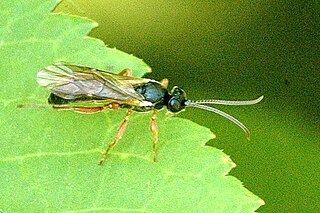
Triclistus pallipes is a species of ichneumon wasp in the family Ichneumonidae. It is a parasitoid of Epermenia chaerophyllella larvae and Swammerdamia pyrella cocoons
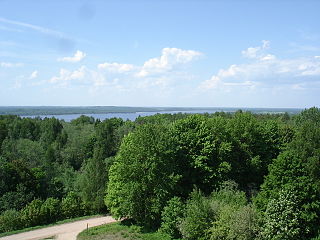
Sauka Nature Park is located in Jēkabpils Municipality in Elkšņi, Sauka and Rite parishes in the Selonia region of Latvia. The nature park is located in the highest part, in its territory there are Saukas ezers, Big Lake Klauce, Bukūzis, Aklais Lake, Klauce River and Dūņupe. To the east of Lake Sauka is Ormaņkalns Hill. The nature park acquired the status of national protection in 1987. Area of the territory 54 km 2 .

